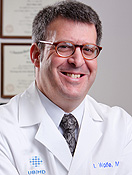News
Wolfe organizes major meeting
on myasthenia gravis
-
 Print
Print -
 Comments
Comments
-

“Myasthenia gravis is one of neurologic medicine’s success stories in terms of diagnosis and advancement in treatment.”
Gil I. Wolfe, Irvin and Rosemary Smith Professor and chair of the Department of Neurology, School of Medicine and Biomedical Sciences, played a major role in the 12th International Conference on Myasthenia Gravis and Related Disorders, held earlier this week in New York City.
A leading authority on a range of neuromuscular disorders, Wolfe was one of four organizers of the conference, which takes place every five years. The meeting, which featured 50 speakers and more than 100 poster sessions, as well as a “hot topics” session, gathers the world’s most prominent researchers on myasthenia gravis and related neuromuscular junction disorders, both acquired and hereditary.
Myasthenia gravis is the most common disease of neuromuscular transmission and results from an immune-mediated disruption of communication between nerve and muscle—the neuromuscular junction. Symptoms include a droopy eyelid, blurred or double vision, difficulty breathing and muscle weakness.
Only a few decades ago, approximately a third of all patients with MG died from it, but new diagnostic techniques and treatments developed over the past three decades have dramatically improved both the quality of life and longevity of patients. Today, the lifespan for myasthenia gravis patients matches that of the general population.
“Myasthenia gravis is one of neurologic medicine’s success stories in terms of diagnosis and advancement in treatment,” says Wolfe.
The disease is diagnosed through the use of blood tests for one of two antibodies; a third antibody related to MG also has been discovered and was discussed at this week’s meeting. Still, Wolfe says, some treatments don’t work as fast or as well for some patients and many treatments, which are typically immunosuppressive, have significant side effects.
In addition to being one of the primary conference organizers, Wolfe presented at the meeting an update on a major, international National Institutes of Health-funded clinical trial of which he is clinical chair. The trial concerns a surgical procedure called thymectomy, which is routinely performed on MG patients with thymoma, a chest tumor; the study is assessing the procedure’s potential in helping MG patients who do not present with a chest tumor.
Myasthenia gravis affects approximately 60,000 Americans and its incidence has been steadily increasing, in part due to improved diagnostic techniques and an aging population.
The conference was sponsored by the New York Academy of Sciences and the Myasthenia Gravis Foundation of America Inc.

Reader Comments